deltaH
Dangerous source of unreferenced speculation
    
Posts: 1663
Registered: 30-9-2013
Location: South Africa
Member Is Offline
Mood: Heavily protonated
|
|
Toma's acid salt: ammonium guanidinium bisulfate sulfuric acid salt
WARNING: This preparation involves boiling strong concentrated superacids that would corrode flesh instantly if it lands on you and also giving
terrible thermal burns in addition to chemical burns. It should only be attempted while wearing a plastic apron, face shield, thick rubber gloves and
labcoat while working in a fume cupboard and having a water shower source nearby. If you choose to carry out this procedure, then you do so entirely
at your own risk!
From my investigations into trying to decarbonate/hydrolyse urea into ammonium bisulfate in sulfuric acid media, I appear to have stumbled upon the
formation of a peculiar double salt instead and so have decided to split this away from that topic.
The salt's proposed formula is NH4•C(NH2)3•2HSO4•2H2SO4, so I
suppose an appropriate name might be ammonium guanidinium bisulfate sulfuric acid salt? ChemSketch's IUPAC naming engine gives:
ammonium diaminomethaniminium hydrogen sulfate - sulfuric acid (1:1:2:2)
It's interesting because it's a double salt and also an acid salt where the acid is incorporated into the crystal lattice as a 'solvent of
crystallisation'. It might be useful as a cheap, highly soluble solid source of concentrated sulfuric acid that is also fairly inert and not too low
melting making it possibly attractive for organic reactions and as a highly acidic electrolyte when molten. Irrespective, I think it's lovely 
The reaction I used to prepare it (assuming it is what I think it is) would be:
2(NH2)2CO(s) + 4H2SO4(l) + heat =>
NH4•C(NH2)3•2HSO4•H2SO4(l) + CO2(g)
I prepared it as follows:
To 1000ml dilute sulfuric acid (37% H2SO4, estimated by density) was added 113g urea prills in a large 5l heat and acid
resistant glass pot (Vision cookware from Corning). NB: it is essential that one has at least five times the volume a container as the mixture will
form a rising effervescent froth later on and you need the freeboard space to prevent spillover! This was then boiled on a medium flame until the
volume was greatly reduced and boiling subsides. Then a slight effervescence is noticed by the formation of smaller bubbles that don't form vapour
condensation (steam). At this point the mixture is carefully watched as the effervescence will gradually accelerate and then run away creating a
rising froth. When this occurs, the heating is immediately turned off to manage the effervescence which subsides soon afterwards. Thereafter, gentle
heating is continued until a clear solution with no effervescence is observed. Heating is then turned off and the clear solution solidifies into a
slightly moist transparent mass of crystals (mine were slightly discoloured amber presumably because I used fertiliser grade urea prills and OTC
battery acid).
WARNING: THE PRODUCT IS EXTREMELY ACIDIC AND CORROSIVE!
See photo's attached.
Is this a novel salt? Also, would somebody skilled and with means to carry this out safely please repeat this preparation and confirm my results? Any
help with characterisation would also be greatly appreciated, for example a m.p determination.
I would also appreciate it if it could be titrated to determine whether the acid content is right. I don't have the means to conduct an accurate
titration.
I do not as yet know what's the best for recrystallisation (if it is to be conducted at all). Perhaps this could be done from a small volume of conc.
sulfuric acid followed by filtering under suction when cooled. I would strongly advise against washing with anything as the crystals are
probably too soluble in many solvents! If necessary, activated carbon might be used to decolourise it in the melt followed by hot filtration, but the
discolouration problem might be solved simply by employing purer reagents.
Thanks!
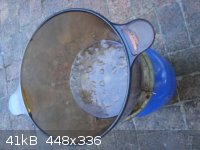 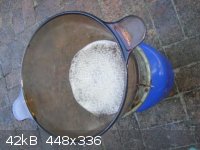 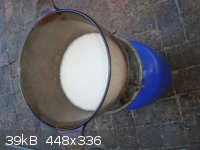 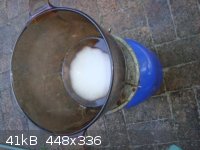 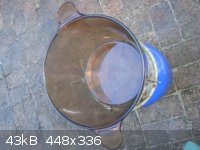 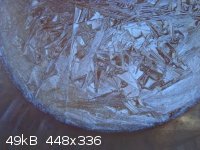
[Edited on 4-11-2013 by deltaH]
|
|
|
kristofvagyok
National Hazard
   
Posts: 659
Registered: 6-4-2012
Location: Europe
Member Is Offline
Mood: No Mood
|
|
Quote: Originally posted by deltaH  | | WARNING: This preparation involves boiling strong concentrated superacids that would corrode flesh instantly if it lands on you and also giving
terrible burns. |
Dilute sulfuric acid is not a superacid, I would recommend to read why the Nobel Prize in Chemistry 1994 was awarded. It was given to George A. Olah
"for his contribution to carbocation chemistry". Read a bit from this, superacids are well described in his work.
Quote: Originally posted by deltaH  | | The salt's proposed formula is NH4•C(NH2)3•2HSO4•2H2SO4, so I
suppose it's IUPAC name might be ammonium guanidinium bisulfate sulfuric acid salt? |
Where did you get that? Looks really strange.... Any elemental analysis or anything else? I think you meant ammonium-sulfate what would be:
(NH4)2SO4
Quote: Originally posted by deltaH  | The reaction I used to prepare it (assuming it is what I think it is) would be:
2(NH2)2CO(s) + 4H2SO4(l) + heat =>
NH4•C(NH2)3•2HSO4•H2SO4(l) + CO2(g) |
Actually it's not that complicated:
2(NH2)2CO + H2SO4 => (NH4)2SO4 + 2 CO2
Maybe some sulfuric acid is left in it, wash it with a little ice cold alcohol to get pure product(:
I have a blog where I post my pictures from my work: http://labphoto.tumblr.com/
-Pictures from chemistry, check it out(:
"You can’t become a chemist and expect to live forever." |
|
|
deltaH
Dangerous source of unreferenced speculation
    
Posts: 1663
Registered: 30-9-2013
Location: South Africa
Member Is Offline
Mood: Heavily protonated
|
|
Hi kristofvagyok
| Quote: | | Dilute sulfuric acid is not a superacid |
It's not dilute, while it starts out dilute, because of the cation, this boils up into a molten pool of my product salt which is very acidic indeed.
While not technically a super acid like HSbF6, I want people to take note that this stuff is nevertheless extremely acidic.
Strictly speaking, a superacid is defined as anything with a hammett acidity function of less than -12 (sulfuric acid), so this might be close enough
or slightly stronger in fact, if it is what I think it is! Until I'm proven wrong, I'm keeping it as is if you don't mind because I think there is
good reason for doing so and there's no evidence to the contrary as of yet.
| Quote: | | Where did you get that? Looks really strange.... Any elemental analysis or anything else? I think you meant ammonium-sulfate what would be: (NH4)2SO4
|
No elemental analysis, I am an amateur scientist.
I was hoping to prepare ammonium bisulfate from urea, hence why I used a sulfuric acid to urea ratio of 2. BUT I noticed several things that didn't
fit with this being ammonium bisulfate and lead me to propose that instead an ammonium guanidium double salt formed. The observations were:
(i) The produce appeared to be a single crystalline mass of excellent yield (only slightly wet).
(ii) The amount of CO2 evolved appeared too little for the formation of the bisulfate (granted subjective), yet proceeded rapidly when it kicked off
and also subsided sharply there afterwards, appearing to hit the theoretical consumption of a limiting reagent. At first I though it might have been
water as the reaction only commences when the solution had lost most of it's water, so I repeated adding more, but it didn't appear to increasing
effervescence.
(iii) The salt required roughly double the amount of NaOH to neutralise than would it had it been ammonium bisulfate. Again, not accurately carried
out, but an estimate.
(iv) Nevertheless, the salt contained large amounts of ammonia because a strong ammonia smell was present on addition of excess base.
So put all these observations together and also bearing in mind the conditions and I come to the conclusion that this is the double salt of ammonia
and guanidine with two bisulfates and two free sulfuric acids.
This would seem to explain why I got [seemingly] only half the expected CO2 production and twice the stoichiometric acidity and one crystalline
product mass from a sulfuric acid to urea stoichiometry of 2.
I can only surmise for now that the urea's amine group attacked a protonated urea carbonyl to eliminate water and form a hydrolysable guanidine
carbamate intermediate which was broken down to guanidinium and ammonium bisulfates and CO2. This is somewhat supported by another observation, that a
batch prepared with 1.5 H2SO4 to urea effervesced much faster... almost explosively... probably because there was a higher concentration of
unprotonated urea to act as nucleophile due to there being less acid.
Above all, bear in mind that a single crystalline product is formed and bear in mind the stoichiometry present and all the observations made. It's
very slightly wet, but mostly one solid crystalline mass, so all that acid is there and this gives a big clue as to what it can be or can't be
(combined with the other experimental observations).
Finally, I am not sure this is what it is, I merely have some experimental reasons for believing it and am putting it out here to be vetted by my
peers in the beginnings section of the forum. If proven wrong, then so be it. This is part of scientific evaluation after all.
| Quote: | | 2(NH2)2CO + H2SO4 => (NH4)2SO4 + 2 CO2 |
I used acid to urea ration of 2, so if this equation was the
case, you would have a lot of extra H2SO4 which would immediately form NH4HSO4 with the sulfate.
But my product required too much base to neutralise to be NH4HSO4 so can't be that either. There must have been lots of acid left over even on top of
that and was also in a solid crystalline form.
[Edited on 3-11-2013 by deltaH]
|
|
|
kristofvagyok
National Hazard
   
Posts: 659
Registered: 6-4-2012
Location: Europe
Member Is Offline
Mood: No Mood
|
|
Quote: Originally posted by deltaH  | (i) The produce appeared to be a single crystalline mass of excellent yield.
(ii) The amount of CO2 evolved appeared too little for the formation of the bisulfate (granted subjective), yet proceeded rapidly when it kicked off
and also subsided sharply, appearing to a theoretical consumption of a reagent.
(iii) The salt required almost double the amount of NaOH to neutralise than would it had it been ammonium bisulfate. Again, not accurately carried
out, but first estimate.
(iv) Nevertheless, the salt contained large amounts of ammonia because a strong ammonia smell was present on addition of excess base.
So put all these observations together and also bearing in mind the conditions and I come to the conclusion that this is the double salt of ammonia
and guanidine with two bisulfates and two free sulfuric acids. |
Try to isolate a pure product. Wash it with alcohol or acetone to get rid of excess sulfuric acid, water and dry it in vacuum. Since ammonium-sulfate
and ammonium bisulfate is highly hydroscopic and it could also crystallize with some water, it could easily happen that some water and with that some
of the unreacted sulfuric acid is in there, between the crystals.
For the ammonia smell while the reaction with a base (NaOH as you wrote) it is simple:
2 NaOH + (NH4)HSO4 = Na2SO4 + NH3 + H2O
That only means that you have some ammonium-(bi)sulfate there.
And since you used excess of a reagent it doesn't have to mean that something else happened. Also the evolving CO2 is hard to measure by your eyes. A
gas burett is good for this.
Quote: Originally posted by deltaH  | | I can only surmise for now that the urea's amine group attacked a protonated urea carbonyl to eliminate water and form a hydrolysable guanidine
carbamate intermediate which was broken down to guanidinium and ammonium bisulfates and CO2. |
There is no amine in urea, that's amide, and it wont react as you wrote
I have a blog where I post my pictures from my work: http://labphoto.tumblr.com/
-Pictures from chemistry, check it out(:
"You can’t become a chemist and expect to live forever." |
|
|
deltaH
Dangerous source of unreferenced speculation
    
Posts: 1663
Registered: 30-9-2013
Location: South Africa
Member Is Offline
Mood: Heavily protonated
|
|
Your explanation doesn't explain why I required double the amount of NaOH to neutralise compared to what I would have needed if it was completely
NH4HSO4.
One might suspect that only half converted to NH4HSO4, but then why the solid singular crystalline mass where the crystals are only slightly moist?
Also if only half converted, there would still be a lot of urea in there. Why would this urea decide to sharply stop reacting like that (recall the
only other possibility was that water ran out, but I checked for this by repeating with more water).
Also, I wouldn't wash this with anything because I suspect it will dissolve, at least in part, in a great many solvents. Think about it, you
have those loose H2SO4's in the crystal lattice that will easily dissolved, then you have a solution containing H2SO4 that would probably help a lot
to dissolve bisulfates, plus your cations are of the larger variety, well ammonium not so much, but guanidinium definately... that also lends itself
to organic solubility... in fact, this is another thing that might make this salt attractive for some applications.
I would say prepare it with as accurate a mole ratio of H2SO4 to urea = 2 and you should have a relatively pure product is you used pure reagents. I
think that's about the best one could do. If you really must, one could use a very slight excess of sulfuric acid, say a ratio of 2.1, to ensure you
consume the urea fully, but you must be prepared that your crystals will appear more wet by acid afterwards.
As for all the other why-don't-you-do-it-like-this... remember I don't have ANY equipment except some pots, a gram scale, a gas stove and my eyes and
hands 
Let's try to stick to disproving that this is what I think it is.
Hmm... since it appears to melt at reasonable temperatures (don't ask me what that is exactly because I don't have a thermometer), I would imagine
this would make for nice super acidic electrolysis media... in fact I think I might use it for my glycerol electrolytic reforming idea when my
electrodes arrive. Yeah! I just love it when threads cross pollinate! 
*********************************
Just wanted to show you my DOH! moment... see what the stuff did to my plastic egg lifter which I presume is made of a block co-polymer (no markings
but it says resistant to 210C and it's fairly rigid).
That white isn't a salt, it doesn't wash off and the surface is visibly pitted.
That damage was done by stirring with a little added water 
So, yeah... polyesters, polyamides and anything else that's hydrolysable is a no-no. Strictly polyethylene and polypropylene should be used.
My Corning Vision pot is fine though, no visible degradation whatsoever, as expected.
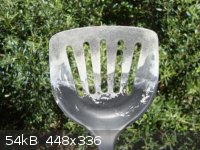
[Edited on 4-11-2013 by deltaH]
|
|
|
woelen
Super Administrator
        
Posts: 8082
Registered: 20-8-2005
Location: Netherlands
Member Is Offline
Mood: interested
|
|
I have read your experimental results and I also read watson.fawkes' response in the other thread about urea/H2SO4. I think that the formation of
sulfamic acid indeed is a good candidate for explanation of your observations.
Sulfamic acid is quite soluble in water (I have this compound and have done quite a few experiments with that). Your crystalline mass may well have
lots of water in it as well (as water of crystallization, or maybe trapped between large crystal sheets or needles) and that may explain the low
melting point of the crystalline mass. I have had a similar experience myself last weekend, which may demonstrate what I want to say:
I have made a copper(en) complex and from 10 ml of liquid I obtained 7 ml or of crystalline material. When I pressed this dry between filterpaper and
paper tissue and let it dry, I could fill up an 8 ml vial nearly to the rim.
I also made a cobalt(en) complex, also from 10 ml of liquid. I again obtained 7 ml or so of wet crystalline mass. When, however, I pressed this dry
between filterpaper and paper tissue, then a lot of liquid squeezed out and less than 1 ml or so of solid material remained. This material is very
soluble and large amounts of concentrated solution were absorbed by the tissue.
You may have a similar effect in your crystalline mass. It would be interesting to take out some of this material and break it down and press firmly.
I can imagine you get a mud, with a lot of colorless liquid above it and a layer of crystalline material under the liquid.
---------------------------------------------
Your effervescence and sudden stopping of that may be because the splitting of urea to CO2 and other things occurs when free H2SO4 is present. Any
H2SO4, bound to urea as the sulfate salt may not be capable of destroying the urea. So, I can also imagine that a large part of the H2SO4 simply is
present as urea.H2SO4.
What you should do is search for a test, which is specific for guanidine and which works in the presence of urea and lots of acid. A similar test
should be done for sulfamic acid, which works in the presence of guanidine, urea and a lot of acid. If you can show that there is a lot of guanidine,
while at the same time there only is a small amount or no sulfamic acid, then you have a much stronger case.
I understand that this can be difficult in a home setting. Many people simply don't have all the required reagents and equipment. I, however, am
inclined to say, that if you really want to do this kind of chemistry and want to be able to conclude things from your experiments, then you need a
basic set of chemicals and apparatus.
|
|
|
deltaH
Dangerous source of unreferenced speculation
    
Posts: 1663
Registered: 30-9-2013
Location: South Africa
Member Is Offline
Mood: Heavily protonated
|
|
Thank you woelen. The crystals are quite hard, I scooped the mass aside with my spatula, as you can see, there is not much liquid
there (see photo below).
I think I took this photo from my second batch where I withheld 1/4 of the acid to check if reheating with more water increases decarbonation
significantly. The first batch was very similar except lighter with fewer impurities.
Remember that I am carrying this out with a gram scale and a crude estimation of the battery acid concentration, so it's hard for me to tell how much
extra acid may or may not be there, but the crystals are large and only slightly moist, so I don't think I am that far off.
Sadly I will not be able to provide more accurate quantitative information for now about this material. I am hoping that someone on the SM community
might take an interest into this and repeat my experiment under better conditions and collaborate in this study.
Certainly sulfamate/sulfamic acid may be an impurity, the question is it a major component? Certainly a test for guanidinium ions would be extremely
useful... I will try to find/make a simple enough test for guanidine that I might be able to carry out.
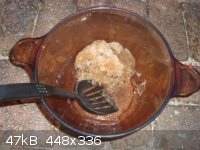
My main doubt about sulfamic acid formation here is that this mixture should not be sufficiently sulfonating for the urea sulfamate intermediate to
form. Industrially this is done with oleum to generate this intermediate in good yield. I think the presence of SO3 is important for this to work
well, else if that worked so well with plain sulfuric acid, industry would not bother with the oleum.
Also if sulfamic acid did form significantly from sulfuric acid, then it would also be producing water in the reaction, this would probably have
hydrolysed the sulfamic acid at the high temperatures involved to form ammonium bisulfate and I've already ruled out that this is mostly ammonium
bisulfate.
*******
Okay, discovered that guanidine salts appear to be really good at denaturing proteins but I think so is urea, so I don't think this helps much (was
thinking of neutralising, then adding some raw egg albumin solution and seeing if it turns white?). Apparently guanidine hydrochloride is a far more
powerful denaturant than urea though.
*******
Second aside, I don't think that the possibility of forming guanidinium ions in this reaction is so incredibly peculiar/unprecedented, after all, I
recall reading that urea and ammonium nitrate can be reacted to form nitroguanidine (from wiki's article about NG). Those conditions might be related
to what is going on here... except we have stronger acidic conditions, but the presence of some ammonium is already confirmed. But that's just an
aside for now.
[Edited on 4-11-2013 by deltaH]
|
|
|
vulture
Forum Gatekeeper
    
Posts: 3330
Registered: 25-5-2002
Location: France
Member Is Offline
Mood: No Mood
|
|
| Quote: |
Let's try to stick to disproving that this is what I think it is.
|
While I like your enthusiasm and applaud your experimental efforts, Let's try to stick to disproving that this is what I think it is, is a
very bad way of doing science.
I claim that the crystals you observe are produced by gnomes who take a dump in your reaction mixture when you're not watching and are really adept at
hiding themselves. Please disprove this claim.
| Quote: |
As for all the other why-don't-you-do-it-like-this... remember I don't have ANY equipment except some pots, a gram scale, a gas stove and my eyes and
hands
|
That's too bad, but you can't expect us to come up with explanations and verifications of your theory. Especially because you show a stubborn tendency
to just seek approval of your hypothesis and don't seem to appreciate requests for proof or critical counterarguments.
[Edited on 4-11-2013 by vulture]
One shouldn't accept or resort to the mutilation of science to appease the mentally impaired.
|
|
|
deltaH
Dangerous source of unreferenced speculation
    
Posts: 1663
Registered: 30-9-2013
Location: South Africa
Member Is Offline
Mood: Heavily protonated
|
|
No not at all vulture, merely being honest that I can't carry out a lot of the suggestions proposed.
Secondly, proposing a hypothetical formula that fits my experimental observations and then seeking to disprove it is, I believe, the standard
scientific approach is it not?
| Quote: | | I claim that the crystals you observe are produced by gnomes who take a dump in your reaction mixture when you're not watching and are really adept at
hiding themselves. Please disprove this claim. |
This is not a falsifiable hypothesis as there is no known test for a gnome having done this, nor for the existence of a gnome. You might has well have
said that god created my chemical, I can neither prove nor disprove such an assertion.
On the other hand, by proposing that my chemical is an ammonium guanidinium bisulfate sulfuric acid salt, one can construct specific tests to
invalidate the presence of those groups. Thus my hypothesis is falsifiable and so there is nothing wrong with stating it as such and trying to
disprove it.
[Edited on 4-11-2013 by deltaH]
|
|
|
vulture
Forum Gatekeeper
    
Posts: 3330
Registered: 25-5-2002
Location: France
Member Is Offline
Mood: No Mood
|
|
| Quote: |
On the other hand, by proposing that my chemical is an ammonium guanidinium bisulfate sulfuric acid salt, one can construct specific tests to
invalidate the presence of those groups. Thus my hypothesis is falsifiable and so there is nothing wrong with stating it as such and trying to
disprove it.
|
See my reply in your other topic. You are doing nothing to falsify your hypothesis except engaging in dubious post diarrhea.
Since you keep demonstrating the same stubborn attitude I'm going to close this thread because it is obvious you will just keep on posting till
everybody else has given up trying to talk sense in to you.
One shouldn't accept or resort to the mutilation of science to appease the mentally impaired.
|
|
|
deltaH
Dangerous source of unreferenced speculation
    
Posts: 1663
Registered: 30-9-2013
Location: South Africa
Member Is Offline
Mood: Heavily protonated
|
|
Continuation of investigation of Toma's acid salt
Ok so my thread "Toma's acid salt: ammonium guanidinium sulfate sulfuric acid salt" was shut down. I've appealed this decision. In the meantime I'd
like to continue with my investigations...
So when we last left off, it was suggested that this material may in fact be mostly sulfamic acid. There is also doubts whether this does not also
contain large amounts of urea.sulfuric acid salt. So I'm now trying to find simple test that I can can conduct with the means that I have at hand.
One thought that came to mind is to add some KNO3 to a small amount of my salt and warm gently. The thinking is based on this patent which I think is
familiar to some members:
"Process for producing nitrous oxide", US 4376105 A
The basis for my test is that if my salt contains appreciable amounts of sulfamic acid or urea, under the very concentrated sulfuric acid present,
when I add KNO3, I will generate NO2+ which would oxidise sulfamic acid OR urea to form intermediates that quickly decompose to nitrous oxides which
should be visible as bubbling.
If the product is mostly NH4.C(NH2)3.2HSO4.H2SO4 as I think it is, then very little gas production production would occur, however I might form some
nitroguanidine.
I am worried about the safety of carrying out such a test, even in very small amounts. Can I do it at room temperature with no heating and just let it
stand, surely gas bubbles will become visible in time?
Would the NO2+ be able to react with ammonium ions and give a false positive test under these conditions?
|
|
|
bfesser
Resident Wikipedian
    
Posts: 2114
Registered: 29-1-2008
Member Is Offline
Mood: No Mood
|
|
Have you no common sense? Words of advice: don't piss off the moderators.
[edit] Further posts get deleted, not merged. Don't waste your time.
[Edited on 4.11.13 by bfesser]
|
|
|
bfesser
|
Threads Merged
4-11-2013 at 10:07 |
|